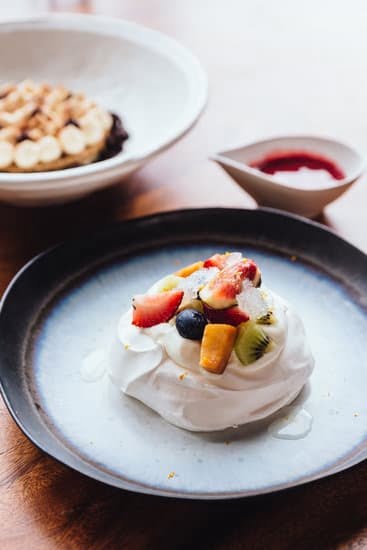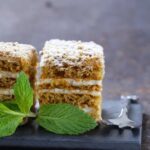Leveling a cake for decorating is a crucial step in the process of creating a beautifully adorned masterpiece. Without a level surface, frosting can become uneven and the overall appearance may lack the professional touch desired. In this article, we will explore the significance of leveling a cake for decorating and how it ensures even distribution of frosting, resulting in stunning results that are sure to impress.
When it comes to cake decorating, having a solid foundation is key. A leveled cake provides the perfect canvas for adding layers of frosting, fondant, or other decorative elements. Not only does leveling ensure a more visually appealing presentation, but it also allows for precise control over the final design. By starting with an even surface, decorators can confidently apply their artistic flair knowing that the cake will provide the ideal backdrop.
In addition to aesthetics, leveling a cake plays a vital role in ensuring flavor consistency throughout every bite. Uneven layers can lead to variations in taste and texture as guests make their way through each slice. A leveled cake guarantees that each portion contains an equal distribution of frosting, filling, and moist crumb – leaving no room for disappointment when indulging in your delicious creation.
By focusing on achieving a level surface before applying any decoration, you are setting yourself up for success as you embark on your cake decorating journey. So grab your tools and get ready to learn all about the essential techniques required to level cakes with precision and professionalism. Get ready to take your baking skills to new heights as we explore the world of leveling cakes for decorating.
Essential Tools for Leveling a Cake
Leveling a cake for decorating requires a few essential tools to ensure precision and achieve the desired results. Here is a comprehensive list of tools that every baker should have in their arsenal for this task:
- Cake Leveler: A cake leveler is specifically designed to slice off the top portion of a cake, creating an even surface. It consists of a long wire or adjustable blade attached to handles on either side. The height can be adjusted according to the desired thickness of the leveled surface.
- Serrated Knife: A serrated knife is another option for leveling a cake if you don’t have a cake leveler. It’s important to choose a knife with small, sharp teeth to make clean cuts without tearing the cake. Make sure the knife is long enough to span the width of the cake.
- Dental Floss: Dental floss can be surprisingly effective in leveling cakes, especially light and delicate ones like sponge cakes. Simply hold one end of a long piece of dental floss tightly between your hands and tightly pull it through the cake horizontally at the desired level.
- Dental Floss Threader: For layered cakes that require precise leveling between each layer, a dental floss threader can come in handy. This tool allows you to easily insert dental floss into the middle section of the cake without disturbing the surrounding layers.
Each tool has its own advantages and suitability depending on the type of cake being leveled and personal preference. Experimenting with different tools can help you find the one that works best for you.
Remember, having these essential tools readily available will make leveling cakes for decorating easier and more efficient, ensuring that your final product looks professional and visually appealing.
Preparing the Cake for Leveling
Before you begin leveling your cake, it is important to ensure that it is properly cooled. Cooling the cake completely prevents it from breaking or crumbling during the leveling process. To cool your cake properly, follow these steps:
- Remove the cake from the oven: Once your cake is baked and has a golden brown color, carefully remove it from the oven using oven mitts to protect your hands from heat.
- Allow the cake to cool in the pan: Leave the cake in its baking pan for about 10 minutes, allowing it to settle and cool slightly before attempting to remove it.
- Transfer the cake to a cooling rack: After 10 minutes, gently invert the pan onto a cooling rack to release the cake. Make sure not to rush this step as removing the cake too quickly can cause it to break apart.
- Let the cake cool completely: Allow your cake to cool completely on a cooling rack before attempting to level it. This usually takes around one hour but may vary depending on the size of your cakes and your ambient room temperature.
Once your cake is thoroughly cooled, you can proceed with removing any unwanted domed or uneven surfaces before leveling. Removing these surfaces ensures that you have a smooth and even foundation for decorating.
To do this:
- Place your cooled cake on a clean work surface and gently run a long serrated knife horizontally across the top of the cake.
- Remove any domed or uneven portions of the cake by simply cutting horizontally until you achieve an even surface.
- Alternatively, you can use a piece of dental floss or a dental floss threader threaded through both ends of a serrated knife blade to create an improvised leveler tool for slicing off any excess portions of your cake.
By following these tips and techniques for preparing your cake before leveling, you will maximize your chances of achieving a perfectly leveled surface for decorating.
Choosing the Right Leveling Method
When it comes to leveling a cake for decorating, there are several methods to choose from. Each method has its pros and cons, so it’s important to consider factors such as ease of use, precision, and the type of cake being leveled. Here, we will explore some common leveling methods and their variations.
One popular tool for leveling cakes is a cake leveler. This handy tool consists of a long serrated blade attached to a handle. The blade can be adjusted to different heights, allowing you to easily slice off the domed or uneven top of the cake. Cake levelers are particularly useful for achieving consistent results with layered cakes.
Another option is using a serrated knife. This method requires a steady hand and precision, but it can be effective in achieving an even surface. To use a serrated knife, hold it horizontally and slowly glide it back and forth across the top of the cake while applying gentle pressure.
For those who prefer a more unconventional approach, dental floss or dental floss threaders can also be used as leveling tools. Simply stretch a piece of dental floss tightly between your hands or use a dental floss threader like you would with braces. Carefully slide it through the center of the cake, making slow sawing motions while maintaining an even pressure on both ends. This technique works best with softer cakes like sponge cakes.
Each leveling method has its own unique benefits and considerations. When choosing the right method for your needs, consider factors such as your level of experience and confidence, the type of cake you are working with, and any specific challenges you may encounter.
| Leveling Method | Pros | Cons |
|---|---|---|
| Cake Leveler | – Adjustable heights for consistent results | – Requires a specific tool |
| Serrated Knife | – Wide availability, no additional tools needed | – Requires steady hand and precision |
| Dental Floss / Dental Floss Threader | – Unconventional yet effective method | – Works best with softer cakes |
Step-by-Step Guide to Leveling a Cake
Step 1: Cooling and Preparing the Cake
Before you begin leveling your cake, it’s crucial to ensure that it has cooled completely. This will prevent the cake from breaking or crumbling during the leveling process. Allow the baked cake to cool in its pan for about 10 minutes, then transfer it onto a wire rack to cool completely.
Once your cake has cooled, you’ll need to remove any domed or uneven surfaces before you can level it. To do this, place your cooled cake on a clean work surface and carefully slice off the dome using a long serrated knife. Take your time and use a gentle sawing motion to achieve an even cut.
Step 2: Choosing Your Leveling Method
There are several methods you can use to level your cake, depending on your preference and the tools available to you. One popular method is using a cake leveler, which is specifically designed for this task. Simply adjust the leveler’s height according to how much you want to trim off, then glide it across the top of the cake in one smooth motion.
If you don’t have a cake leveler, don’t worry. A serrated knife can also be used effectively. Hold the knife parallel to the work surface and gently cut through any domes or uneven areas of the cake. Be sure to keep an eye on maintaining an even cut throughout.
For those looking for a more unconventional approach, dental floss or a dental floss threader can also be used to level a cake. Slide a length of unscented dental floss underneath the Cake’s dome or uneven portion, then pull each end upwards in opposite directions until the dental floss slices through evenly.
Step 3: Finishing Touches
Once you have leveled your cake, brush away any excess crumbs from its surface using a pastry brush or a clean, dry paper towel. This will ensure a clean canvas for frosting and decorating.
To further enhance the levelness of your cake, consider using a flat cake board or cardboard round as a stable base. Place it on top of the cake and gently press down to ensure it sits evenly.
Congratulations. You have successfully leveled your cake in preparation for decorating. Now you can move forward with confidence knowing that your foundation is smooth and even, making it easier to create professional-looking designs on your beautifully leveled cake.
Troubleshooting Common Leveling Issues
Leveling a cake for decorating can sometimes be a challenging task, and it is not uncommon for issues to arise during the process. However, with some troubleshooting techniques, these problems can be easily resolved. In this section, we will identify common leveling issues encountered and provide practical solutions to ensure a perfectly leveled cake.
One common issue when leveling a cake is uneven cuts. This can result in an asymmetrical appearance when the cake is frosted and decorated. To overcome this problem, it is important to use a leveler or serrated knife that is long enough to span the width of the cake.
Start by making gentle, even slices across the top of the cake while keeping your knife parallel to the countertop. If you notice any uneven areas, gently apply pressure on those sections with the knife until they are level with the rest of the cake.
Another challenge that may arise is cake crumbling during leveling. This can happen especially if you are working with a delicate or crumbly cake such as sponge or chiffon. To prevent this issue, it is crucial to ensure that your cake has cooled completely before attempting to level it. Cooling allows the structure of the cake to set and hold together better, reducing the risk of crumbling.
Additionally, if you find that your leveling tool is sticking to the cake, there are steps you can take to address this problem. One solution is using a non-stick spray or coating your leveling tool with a thin layer of vegetable oil before each cut. Another option is placing parchment paper or plastic wrap between your tool and the cake surface – this helps reduce friction and prevents sticking.
By addressing these common leveling challenges, you can achieve a perfectly leveled cake for decorating without any unwanted surprises along the way. Remember to take your time, make precise cuts, and be patient throughout the process.
Expert Tips for Leveling a Cake with Precision
When it comes to leveling a cake for decorating, precision is key. Achieving a perfectly level surface not only ensures professional results but also provides a solid foundation for your decorative masterpiece. To help you in your quest for cake perfection, we have gathered expert tips from professional bakers and cake decorators who have mastered the art of leveling cakes with precision.
Use a Rotating Cake Stand
One of the top recommendations from experts is to invest in a rotating cake stand. This handy tool allows you to easily rotate the cake while leveling, providing better control and accuracy. As you turn the cake on the stand, it becomes easier to identify any uneven areas and make precise adjustments. Additionally, using a rotating cake stand reduces the need to shift your body position as you level, resulting in smoother cuts and an overall more even surface.
Double-Check Your Measurements
Accurate measurements are crucial when leveling a cake. Experts advise double-checking your measurements before making any cuts. Use a ruler or measuring tape to ensure that each cut is consistent across the entire surface of the cake. Taking extra care with measurements will help maintain uniformity and prevent an uneven final result.
Invest in an Adjustable Leveler
An adjustable leveler is another tool highly recommended by experts. This type of leveler allows you to customize the height according to your needs, ensuring that each cut is made at precisely the desired depth. By using an adjustable leveler, you can achieve consistent results throughout the entirety of the cake without having to worry about varying heights or uneven layers.
Get Guidance from Experts in the Field
Professional bakers and experienced cake decorators have invaluable knowledge and insights when it comes to leveling cakes with precision. Don’t hesitate to reach out to them for advice or attend workshops where they share their expertise. By learning from those who have mastered the art, you can gather valuable tips and tricks that may not be found in conventional guides or articles.
With these expert tips, you’ll be on your way to leveling cakes with precision like a pro. Remember to take your time and practice the techniques that work best for you. By mastering the skill of cake leveling, you’ll lay a solid foundation for beautifully decorated delights that are sure to impress.
Conclusion
In conclusion, mastering the art of leveling a cake is crucial for creating perfectly decorated delights. Leveling a cake ensures that you have a solid foundation to work with and allows for even frosting distribution, resulting in professional-looking results. By following the step-by-step guide and utilizing the essential tools mentioned in this article, you can achieve a flawlessly leveled surface every time.
It is important to remember to properly cool the cake before leveling to prevent any breaking or crumbling. Removing any domed or uneven surfaces beforehand is also key to achieving an even final product. Additionally, choosing the right leveling method for your specific cake type is essential.
Whether you opt for a cake leveler, serrated knife, dental floss, or dental floss threader, each method has its pros and cons. It may be helpful to experiment with different techniques until you find one that works best for you.
As with any skill, practice makes perfect when it comes to leveling cakes. Troubleshooting common issues such as uneven cuts or cakes sticking to the leveling tool will become easier with experience. Remember to seek advice from experts in the field and try out their recommended tips and tricks for precision leveling. Invest in tools like rotating cake stands or levelers with adjustable heights to aid in achieving professional results.
Now armed with the knowledge and techniques outlined in this article, it’s time to put your newfound skills into practice. Share your beautifully leveled cakes on social media platforms or websites dedicated to baking and decorating. Don’t forget to invite others to explore more cake decorating tips and techniques on our blog or website. Happy cake decorating.
Frequently Asked Questions
What is the easiest way to level a cake?
The easiest way to level a cake is by using a long serrated knife or a cake leveler. It’s important to have a steady hand and a sharp blade when leveling the cake to ensure an even cut. To begin, place the cake on a flat surface and gently saw through the top with the knife held parallel to the surface.
Slowly move the knife back and forth while applying light pressure, gradually moving towards one side of the cake until it is leveled. Take your time and make sure not to remove too much cake as it may affect the overall structure.
Do you level a cake when it’s hot or cold?
It is generally recommended to level a cake when it has cooled down completely. While some bakers prefer to level their cakes shortly after they are removed from the oven while still warm, doing so can be challenging as the cake may still be fragile and prone to breaking apart or crumbling.
By allowing the cake to cool down completely, it becomes more stable and easier to work with during the leveling process.
Should you refrigerate cake before leveling?
It is not necessary to refrigerate a cake before leveling unless it specifically states so in the recipe or if you know that refrigerating will improve its texture or make it easier to handle. Refrigeration can harden cakes, especially those that contain buttercream frosting, making it more difficult for them to be properly leveled without cracking or breaking apart.
However, if you are dealing with a delicate sponge or chiffon cake that needs extra stability, chilling it in the refrigerator for a short period before leveling might be beneficial as this can help firm up the texture slightly and make cutting more precise. Ultimately, understanding your specific recipe and its needs will guide whether refrigeration is required prior to leveling your cake.

Welcome to our cake decorating blog! My name is Destiny Flores, and I am the proud owner of a cake decorating business named Cake Karma. Our mission is to provide delicious, beautiful cakes for all occasions. We specialize in creating custom cakes that are tailored specifically to each customer’s individual needs and tastes.





